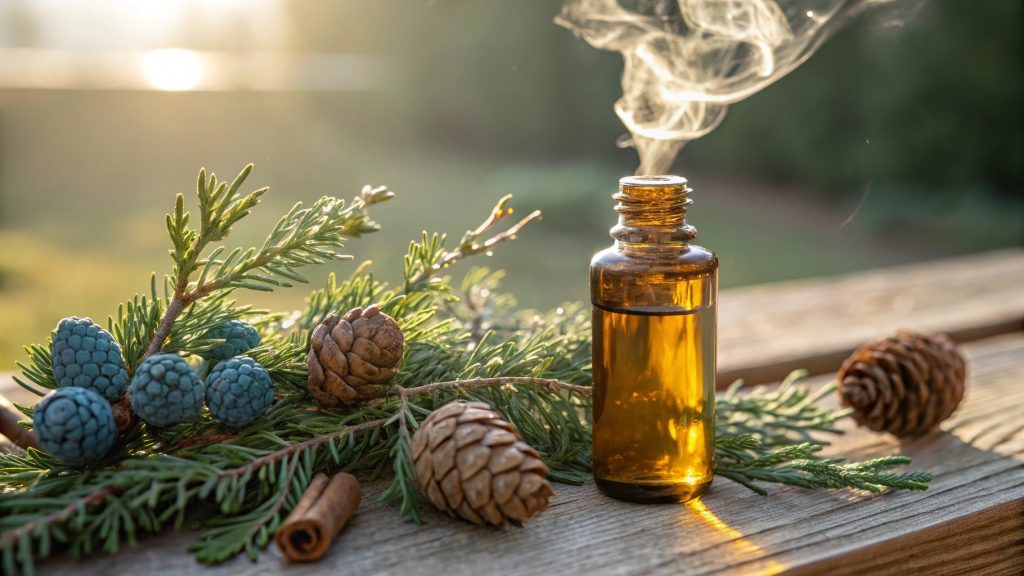Table of Contents - click here
ToggleCypress essential oil stands as one of aromatherapy's most distinctive offerings, extracted from the majestic Cupressus sempervirens tree native to Mediterranean regions. Its sharp, fresh aroma carries both historical significance and modern therapeutic value. While many know this oil for its respiratory benefits, its complete profile reveals a complex blend of chemical compounds and varied applications. Understanding its proper use and safety considerations becomes essential for anyone interested in harnessing its natural properties.
Essential Takeaways
- Cypress essential oil comes from Cupressus sempervirens, a tall Mediterranean evergreen tree that can grow up to 100 feet tall.
- The oil contains α-pinene and δ-3-carene as major components, providing anti-inflammatory and expectorant properties respectively.
- It helps relieve respiratory congestion through its expectorant properties and antimicrobial activity against airborne microorganisms.
- Safe topical application requires a maximum 2% dilution with carrier oil and a patch test before use.
- The oil must be stored in dark amber or cobalt glass bottles at room temperature for optimal preservation.
Latin Name
The Latin name for cypress essential oil is Cupressus sempervirens. The term "sempervirens" translates to "evergreen" or "ever-living."
Tall Evergreen Mediterranean Tree
Standing across Mediterranean landscapes, Italian cypress (Cupressus sempervirens) reaches heights of 65-100 feet (20-30 meters) with its columnar shape and dark green foliage.
These evergreen conifers grow in USDA hardiness zones 7-10, adapted to Mediterranean climates with annual rainfall of 14-30 inches (350-750mm). Their foliage consists of scale-like leaves 2-5mm long, and they produce oval cones 1-1.5 inches (25-40mm) in length.
The bark is thin, gray-brown, and develops vertical fissures with age. Cypress trees tolerate drought conditions and can survive in temperatures as low as 10°F (-12°C). Their root system typically extends to a depth of 6-8 feet (1.8-2.4 meters) in suitable soil conditions.
Relieves Respiratory Congestion
Cypress essential oil contains monoterpenes and terpenes, notably camphene and alpha-pinene, which have expectorant properties. When inhaled through aromatherapy, cypress oil can help loosen mucus secretions in the respiratory system.
The oil demonstrates antimicrobial activity in laboratory studies, particularly against airborne microorganisms. Clinical research specifically documenting cypress oil's effectiveness for respiratory conditions remains limited.
For safe use, cypress essential oil requires dilution with a carrier oil (typically 2-3 drops per tablespoon) before any topical application. Direct inhalation should be limited to 1-2 drops in a diffuser or steam inhalation.
Note: Individuals should consult healthcare providers before using cypress oil for respiratory conditions, especially those with underlying health conditions or taking medications.
Chemistry
Chemical composition of cypress essential oil contains monoterpenes. The major components include α-pinene and δ-3-carene, though exact percentages vary by source and extraction method.
| Compound | Properties |
|---|---|
| α-pinene | Anti-inflammatory |
| δ-3-carene | Expectorant |
| Terpinolene | Antimicrobial |
| Cedrol | Sedative |
Minor components include limonene, camphene, and sabinene. These compounds contribute to the oil's antiseptic and astringent properties when used therapeutically.
General Safety Info
General Safety Guidelines for Cypress Essential Oil
Essential oils, including cypress oil, require proper safety measures for use:
1. Patch test required: Apply diluted oil to small area of inner arm and wait 24 hours to check for reactions
2. Medical Precautions:
- Consult healthcare provider before use during pregnancy or nursing
- Not recommended for those with sensitive skin conditions
- Discuss use with doctor if taking prescription medications
3. Application Safety:
- Keep away from eyes, ear canals, and mucous membranes
- Maximum topical dilution: 2% for adults (12 drops per ounce of carrier oil)
- Never apply undiluted oil directly to skin
- Do not ingest
4. Storage Requirements:
- Store in dark amber or cobalt glass bottles
- Keep at room temperature (20-25°C)
- Place out of direct sunlight
- Keep sealed when not in use
- Store out of children's reach
Discontinue use and seek medical attention if irritation occurs.
Wrap Up
Cypress essential oil, extracted from Cupressus sempervirens, stands as a significant therapeutic agent in aromatherapy and natural medicine. Its potent compounds, particularly α-pinene and δ-3-carene, make it effective for respiratory health and congestion relief. While offering antimicrobial benefits, users must follow proper dilution guidelines and safety protocols. This Mediterranean tree's essence continues to serve as a valuable natural remedy when used appropriately.





